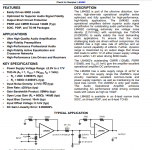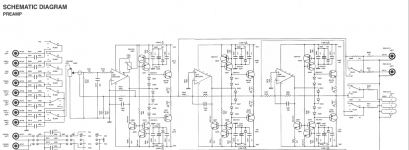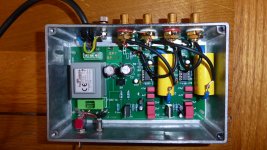For the money, a 5532/4 is very hard to beat. The TLO71/2 don’t cut the mustard for phono amp applications.
I made one, worked with a Thorens table and Philips amp. TL072.
Did the rolling bit with 4558 and 5532 also.
Some in / out resistors were changed from 5218 / 6556 circuit. to lower values.
072 was 20 cents, and NJM5532 was 40 cents when I made it...retail prices here.
Did the rolling bit with 4558 and 5532 also.
Some in / out resistors were changed from 5218 / 6556 circuit. to lower values.
072 was 20 cents, and NJM5532 was 40 cents when I made it...retail prices here.
I've just came across this very interesting comprehensive write up on audio op-amps. Maybe you have all read this before, maybe some of you haven't. Seems like the lm4562 IS one of the best so hopefully I can get my phono pre-amp to work without the popping/ rustling noise but I need to see what happens when I fit the new 5532s. https://nwavguy.blogspot.com/2011/08/op-amp-measurements.html
Browsing through it, I see that it is stated several times that it is not applicable to phono amplifiers. I guess the impedance levels are much lower, so input current noise doesn't matter much.
I just took a look at the NJM2068 https://docs.rs-online.com/8cc9/0900766b80e6f63c.pdf
Itsquite an impressive opamp for the money. With 20k Rsource, the total input referred noise is 1.5 uV which with typical MM cart is good for about 70 dB SNR (5mV)
Itsquite an impressive opamp for the money. With 20k Rsource, the total input referred noise is 1.5 uV which with typical MM cart is good for about 70 dB SNR (5mV)
https://e2e.ti.com/support/audio-group/audio/f/audio-forum/763011/lme49720-pop-cone-noise.
The lme49270 has the same chip as the lm4562.
But as mentioned, the ones that I have are free from this phenomenom.
Hans
The lme49270 has the same chip as the lm4562.
But as mentioned, the ones that I have are free from this phenomenom.
Hans
Last edited:
Hi All. I have just received the NE5532s but it struck me that maybe I will need a DC blocking capacitor at the output of the RIAA phono stage? I have a NAD S100 preamp which, from the schematic, shows no coupling capacitors on the input or on the output. Just to take this question further, perhaps I should have had a dc blocking/coupling capacitor on it anyway even for the the LM4562 as the spec sheet shows 0.1mV input offset? OR is this op-amp factory trimmed to produce no DC offset? I'm pretty sure the NE5532 does produce a DC offset...Very much obliged for guidance with this aspect. Thanks.
Attachments
Last edited:
You are right, your preamp starts with a pot, and DC on a pot should be prevented at all time.Hi All. I have just received the NE5532s but it struck me that maybe I will need a DC blocking capacitor at the output of the RIAA phono stage? I have a NAD S100 preamp which, from the schematic, shows no coupling capacitors on the input or on the output. Just to take this question further, perhaps I should have had a dc blocking/coupling capacitor on it anyway even for the the LM4562 as the spec sheet shows 0.1mV input offset? OR is this op-amp factory trimmed to produce no DC offset? I'm pretty sure the NE5532 does produce a DC offset...Very much obliged for guidance with this aspect. Thanks.
So, you will need a cap plus termination resistor to block DC entering your preamp.
Hans
Just to say I fitted the outputs with polypropylene caps to block the DC which is approx. 0.5V each channel. Sounds pretty good now but I would like to know how flat the response is and will do some measuring with an OPTI-Mike set up playing a test record of white noise when I get the chance ...will post here when I do.
Attachments
Using Pink noise giving a 10dB/oct downward slope might be better. Anyhow, looking forward to see the resultsJust to say I fitted the outputs with polypropylene caps to block the DC which is approx. 0.5V each channel. Sounds pretty good now but I would like to know how flat the response is and will do some measuring with an OPTI-Mike set up playing a test record of white noise when I get the chance ...will post here when I do.
Hans
Didn't read last few pages as kind of tired always reading those absurd discussions about noise in riaas.
What is totaly wrong at first look, for me:
1. LM4562's input bias current! Totaly not suitable for cartridge input stage! Not only kills any dinamic, also magnetizes cartridje to almost unrecoverable levels, and, forever.
2. Even if MM friendly op amp is used, input load is fixed and wrong.
Last riaa i built was with OPA1642. Custom build interconnect with aprox 30pF. No additional cap at the input. Load resistor 90k!!!!! Optimized for AT-VM95. By memory, calculating back, total input capacitance was 67pF and input RCL group being flat up tp 23 or 27kHz. If this 'small' detail (input RCL) is wrong, ewerything after it is neaningless.
Vinyl noise is above 60db anyway, .... ...
What is totaly wrong at first look, for me:
1. LM4562's input bias current! Totaly not suitable for cartridge input stage! Not only kills any dinamic, also magnetizes cartridje to almost unrecoverable levels, and, forever.
2. Even if MM friendly op amp is used, input load is fixed and wrong.
Last riaa i built was with OPA1642. Custom build interconnect with aprox 30pF. No additional cap at the input. Load resistor 90k!!!!! Optimized for AT-VM95. By memory, calculating back, total input capacitance was 67pF and input RCL group being flat up tp 23 or 27kHz. If this 'small' detail (input RCL) is wrong, ewerything after it is neaningless.
Vinyl noise is above 60db anyway, .... ...
If the cartridge manufacturer uses an overdamped RLC network resonance to compensate for a peak due to the mechanical resonance of the stylus and magnet, then tweaking the load resistance to get a flat response of the RLC network will mess up the overall response. If you want to tweak the impedance for a given cartridge instead of following the manufacturer's recommendation and hoping they did their job properly, you should measure the overall response with an accurate test record.
By the way, with ultra-high current noise op-amps and high-inductance cartridges, the noise can get so high that it is even annoying with a record playing. At least that's what I understand from this thread, https://www.diyaudio.com/community/threads/broadcast-riaa-blues.28377/ , with an LT1115 and a 900 mH cartridge.
By the way, with ultra-high current noise op-amps and high-inductance cartridges, the noise can get so high that it is even annoying with a record playing. At least that's what I understand from this thread, https://www.diyaudio.com/community/threads/broadcast-riaa-blues.28377/ , with an LT1115 and a 900 mH cartridge.
Well,...
If mechanical peak is in our range of interest, better look for another one.
For above cartridje AT 'recomends' 200-300pF. With its 550mH, with 200pF electrical resonanse is at 15.2kHz and should be damped with 52.4k. At 300pf we have peack at 12.4kHz, which require 42.8k. After those peaks slope goes down pretty fast. You see, manifacturer advices are already pretty odd. If we add mechanical resonanse in audible range, nothing can help.
To make situation more interesting, inductance is not constant. Coil core and magnet is not stand still system, resulting in imaginary and variable inductance (at least) to be added.
Again, i am talking for input bias current, not for input noise of any kind. First find healty operating conditions, after that look if you have noise problems. Input bias currenr will flow mainly thru cartridge coil and will affect mechanical/magnetic system to levels any noise will be 'even best outcome'. It can bias (mechanicaly) the cantilever that hard so it will be blocked and will not pick anything (worstest case). Also coil core will lose its properties very fast. This bias current is in fact DC, and result is another source of DC voltage at the input, except ones called 'voltage' in datasheets. Because of it' first stage can clip too early than in simulations.
Cartridge itself is really complex thing. Every riaa pre amp related work must start from it. If you ignore it, forget for any good result after that.
Personal opinion, based entirely on personal experience.
If mechanical peak is in our range of interest, better look for another one.
For above cartridje AT 'recomends' 200-300pF. With its 550mH, with 200pF electrical resonanse is at 15.2kHz and should be damped with 52.4k. At 300pf we have peack at 12.4kHz, which require 42.8k. After those peaks slope goes down pretty fast. You see, manifacturer advices are already pretty odd. If we add mechanical resonanse in audible range, nothing can help.
To make situation more interesting, inductance is not constant. Coil core and magnet is not stand still system, resulting in imaginary and variable inductance (at least) to be added.
Again, i am talking for input bias current, not for input noise of any kind. First find healty operating conditions, after that look if you have noise problems. Input bias currenr will flow mainly thru cartridge coil and will affect mechanical/magnetic system to levels any noise will be 'even best outcome'. It can bias (mechanicaly) the cantilever that hard so it will be blocked and will not pick anything (worstest case). Also coil core will lose its properties very fast. This bias current is in fact DC, and result is another source of DC voltage at the input, except ones called 'voltage' in datasheets. Because of it' first stage can clip too early than in simulations.
Cartridge itself is really complex thing. Every riaa pre amp related work must start from it. If you ignore it, forget for any good result after that.
Personal opinion, based entirely on personal experience.
Last edited:
Not necessarily. A fourth-order Chebyshev low-pass filter also has an overdamped resonance at a low frequency and an underdamped resonance at a higher frequency, leading to a more or less flat overall response. Your calculation is for a Q of 1 when the termination resistor is the only thing that damps the electrical resonance, but the cartridge's iron losses also damp it.If mechanical peak is in our range of interest, better look for another one.
For above cartridje AT 'recomends' 200-300pF. With its 550mH, with 200pF electrical resonanse is at 15.2kHz and should be damped with 52.4k. At 300pf we have peack at 12.4kHz, which require 42.8k. After those peaks slope goes down pretty fast. You see, manifacturer advices are already pretty odd. If we add mechanical resonanse in audible range, nothing can help.
I haven't a clue if 72 nA of bias current is enough to damage a cartridge. I never felt the urge to try it.
Sure, you are right, everything can be compensated at few different places.
However, in real world, be it at DIY or for mass production, everyone is looking for filter correctnes and probably wrongly ignores effects/defects at the input. Look few pages early, attempts to check filters, even to 0.1db, no matter how appropriate it is. Once filter is designed this way, the only chance to get it working at end is by doing proper input.
Here we are at DIY community. For us, or at least for me, small price difference is not a limiting factor. If i can eliminate problems by paying a little more, i will do it. Don't see any reason why to accept input biasing, especially as i heared it. If i was designing mass device, price factor will be dramatic and most licely i will accept such drawbacks.
Question was, what is wrong here. I started with input, noted few problems ( pretty stoppers for me) and stoped any further analisis. Any way, i believe remaining part was already discussed.
However, in real world, be it at DIY or for mass production, everyone is looking for filter correctnes and probably wrongly ignores effects/defects at the input. Look few pages early, attempts to check filters, even to 0.1db, no matter how appropriate it is. Once filter is designed this way, the only chance to get it working at end is by doing proper input.
Here we are at DIY community. For us, or at least for me, small price difference is not a limiting factor. If i can eliminate problems by paying a little more, i will do it. Don't see any reason why to accept input biasing, especially as i heared it. If i was designing mass device, price factor will be dramatic and most licely i will accept such drawbacks.
Question was, what is wrong here. I started with input, noted few problems ( pretty stoppers for me) and stoped any further analisis. Any way, i believe remaining part was already discussed.
Well consider this: if the cartridge has 10,000 turns (not an unreasonable value), that's an MMF of 0.7mA-turns, which for a 5mm coil length would be 0.144 A/m. That's absolutely miniscule, even the earth's magnetic field is equivalent to 20--50A/m or so. The resistive heating would be measured in picowatts too.I haven't a clue if 72 nA of bias current is enough to damage a cartridge. I never felt the urge to try it.
No, its not going to do anything. What you need to worry about is transient currents at power-on or power-off, and this often isn't even considered in a design - and they may pass straight through a series capacitor too. This is one reason to prefer lower voltage supplies for phono preamps, keep transient pulses lower in energy.
If you worry about it, put a slow start device like an NTC in the supply, or something to control surges and pulses.
What about 'saturable core inductors' principle and core magnetization? My observations with 5532 at input stage was that after say 10 hours on idle with powered pre amp, then replace input amp with pA one, abovementioned cartridge needs around 2 hours of trash metal playback before it get back to near correct reproduction. With smoother msterial needed time increases a lot.Well consider this: if the cartridge has 10,000 turns (not an unreasonable value), that's an MMF of 0.7mA-turns, which for a 5mm coil length would be 0.144 A/m. That's absolutely miniscule, even the earth's magnetic field is equivalent to 20--50A/m or so. The resistive heating would be measured in picowatts too.
No, its not going to do anything. What you need to worry about is transient currents at power-on or power-off, and this often isn't even considered in a design - and they may pass straight through a series capacitor too. This is one reason to prefer lower voltage supplies for phono preamps, keep transient pulses lower in energy.
- Home
- Source & Line
- Analogue Source
- Spot the mistake on this RIAA pre amp


